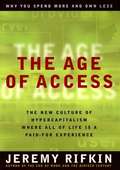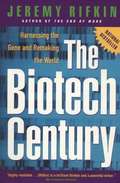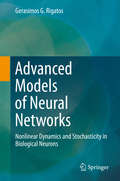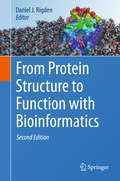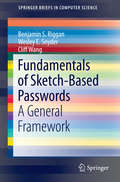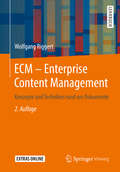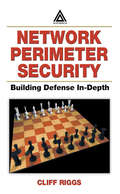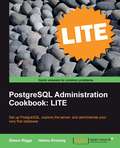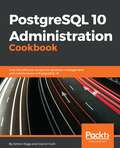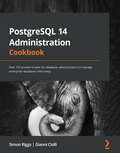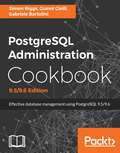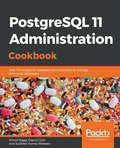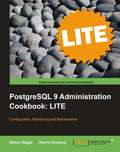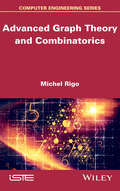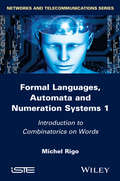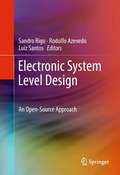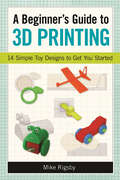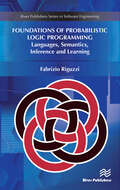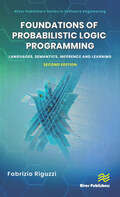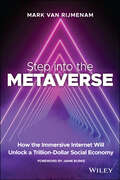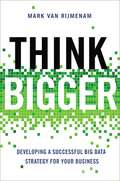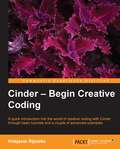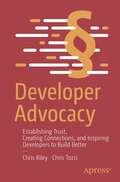- Table View
- List View
Übungsaufgaben zur Mathematik für Ingenieure: Mit durchgerechneten und erklärten Lösungen
by Thomas RießingerDieses erfolgreiche Übungsbuch erscheint jetzt in der 6. Auflage. Der Autor rechnet 159 Übungsaufgaben zur Ingenieurmathematik im Detail vor und erklärt sie. Im Gegensatz zu vielen anderen Übungsbüchern zur Mathematik werden hier nicht nur Ergebnisse oder bestenfalls Lösungsskizzen angegeben. Vielmehr zeigt der Autor, wie man solche Aufgaben vom ersten Ansatz bis zum Ergebnis durchrechnet. Anhand von Beispielen erklärt er die prinzipiellen Methoden, die bei den Aufgaben angewendet werden. Übungsbuch und Lehrbuch "Mathematik für Ingenieure" desselben Autors sind aufeinander abgestimmt.
Übungsaufgaben zur Mathematik für Ingenieure
by Thomas RießingerDieses erfolgreiche Übungsbuch erscheint jetzt in der 7. verbesserten Auflage. Der Autor rechnet 159 Übungsaufgaben zur Ingenieurmathematik im Detail vor und erklärt sie. Im Gegensatz zu vielen anderen Übungsbüchern zur Mathematik werden hier nicht nur Ergebnisse oder bestenfalls Lösungsskizzen angegeben. Vielmehr zeigt der Autor, wie man solche Aufgaben vom ersten Ansatz bis zum Ergebnis durchrechnet. Anhand von Beispielen erklärt er die prinzipiellen Methoden, die bei den Aufgaben angewendet werden. Übungsbuch und Lehrbuch "Mathematik für Ingenieure" desselben Autors sind aufeinander abgestimmt.
The Age of Access: The New Culture of Hypercapitalism, Where all of Life is a Paid-For Experience
by Jeremy RifkinWe are in the midst of a new age in which "concepts, ideas and images--not things--are the real items of value" and where "the purchase of lived experiences becomes the consummate commodity Today's companies avoid amassing physical capital, which can later prove "an albatross" that prevents them from keeping up with rapid technological advances. Instead, they prefer to "outsource ownership," contracting third parties to provide and maintain equipment. This trend combines with others, such as the proliferation of service relationships, to put more emphasis on access than ownership, heralding a time when what companies sell will be human experience itself and all cultural activities will be commodified.
The Biotech Century: Harnessing the Gene and Remaking the World
by Jeremy RifkinIn this seminal book, Jeremy Rifkin explores the epic marriage between computer technology and genetic engineering, and the historic transition into the Age of Biotechnology. Already, Rifkin explains, our economy is undergoing a massive shift away from the Industrial Age and into an era in which giant life-science corporations are fashioning a bioindustrial world. Humanity is on the brink of wielding greater control over the shape of life--how we are born; how our food supply is created; the traits our children may have--than has ever been imagined. But with each step into this new era, we must ask ourselves: At what cost?
Advanced Models of Neural Networks: Nonlinear Dynamics and Stochasticity in Biological Neurons
by Gerasimos G. RigatosThis book provides a complete study on neural structures exhibiting nonlinear and stochastic dynamics, elaborating on neural dynamics by introducing advanced models of neural networks. It overviews the main findings in the modelling of neural dynamics in terms of electrical circuits and examines their stability properties with the use of dynamical systems theory. It is suitable for researchers and postgraduate students engaged with neural networks and dynamical systems theory.
From Protein Structure to Function with Bioinformatics
by Daniel J. RigdenThis book is about protein structural bioinformatics and how it can help understand and predict protein function. It covers structure-based methods that can assign and explain protein function based on overall folds, characteristics of protein surfaces, occurrence of small 3D motifs, protein-protein interactions and on dynamic properties. Such methods help extract maximum value from new experimental structures, but can often be applied to protein models. The book also, therefore, provides comprehensive coverage of methods for predicting or inferring protein structure, covering all structural classes from globular proteins and their membrane-resident counterparts to amyloid structures and intrinsically disordered proteins. The book is split into two broad sections, the first covering methods to generate or infer protein structure, the second dealing with structure-based function annotation. Each chapter is written by world experts in the field. The first section covers methods ranging from traditional homology modelling and fold recognition to fragment-based ab initio methods, and includes a chapter, new for the second edition, on structure prediction using evolutionary covariance. Membrane proteins and intrinsically disordered proteins are each assigned chapters, while two new chapters deal with amyloid structures and means to predict modes of protein-protein interaction. The second section includes chapters covering functional diversity within protein folds and means to assign function based on surface properties and recurring motifs. Further chapters cover the key roles of protein dynamics in protein function and use of automated servers for function inference. The book concludes with two chapters covering case studies of structure prediction, based respectively on crystal structures and protein models, providing numerous examples of real-world usage of the methods mentioned previously. This book is targeted at postgraduate students and academic researchers. It is most obviously of interest to protein bioinformaticians and structural biologists, but should also serve as a guide to biologists more broadly by highlighting the insights that structural bioinformatics can provide into proteins of their interest.
Fundamentals of Sketch-Based Passwords
by Benjamin S. Riggan Wesley E. Snyder Cliff WangThis SpringerBrief explores graphical password systems and examines novel drawing-based methods in terms of security, usability, and human computer-interactions. It provides a systematic approach for recognizing, comparing, and matching sketch-based passwords in the context of modern computing systems. The book offers both a security and usability analysis of the accumulative framework used for incorporating handwriting biometrics and a human computer-interaction performance analysis. The chapters offer new perspectives and experimental results regarding model uniqueness, recognition tolerance, and the human-computer interaction. The results demonstrate that biometrics reduce the equal error rate (EER) by more than 10%, and show that people are capable of accurately reproducing a sketch-based password. Fundamentals of Sketch-based Passwords: A General Framework targets computer scientists and engineers focused on computer security, biometrics, and human factors. Advanced-level students in computer science and electrical engineering will find this material useful as a study guide for their classes.
ECM – Enterprise Content Management: Konzepte und Techniken rund um Dokumente
by Wolfgang RiggertLeistungsfähige, innovative IT-Systeme sind heute für Unternehmen unverzichtbarer Ausdruck ihrer Wettbewerbsfähigkeit. Dem Umgang mit Dokumenten kommt in diesem Kontext zentrale Bedeutung zu. Neuartige Konzepte und Technologien ermöglichen ein hohes Rationalisierungspotenzial. ECM ist ein neues Schlagwort rund um Dokumente. Was verbirgt sich hinter diesem Kürzel? Dieses Buch beleuchtet Idee, Grundlagen und Umsetzung. Ein Werk zum Orientieren, Lernen und Nachschlagen für Studenten und Praktiker gleichermaßen.
Network Perimeter Security: Building Defense In-Depth
by Cliff RiggsToday's network administrators are fully aware of the importance of security; unfortunately, they have neither the time nor the resources to be full-time InfoSec experts. Oftentimes quick, temporary security fixes are the most that can be expected. The majority of security books on the market are also of little help. They are either targeted toward
PostgreSQL 9 Administration Cookbook: LITE Edition
by Simon RiggsWritten in the cookbook style, this book offers learning and techniques through recipes. It contains step-by-step instructions for administrators and developers to manage databases in PostgreSQL. The book is designed in such a way that you can read it chapter by chapter or refer to recipes in no particular order. This book is for Sysadmins, Database Administrators, Architects, Developers, and anyone with an interest in planning for or running live production databases.
PostgreSQL 10 Administration Cookbook: Over 165 effective recipes for database management and maintenance in PostgreSQL 10
by Simon Riggs Gianni CiolliA practical guide to administer, monitor and replicate your PostgreSQL 10 databaseKey FeaturesGet to grips with the capabilities of PostgreSQL 10 to administer your database more efficientlyMonitor, tune, secure and protect your database for optimal performanceA step-by-step, recipe-based guide to help you tackle any problem in PostgreSQL 10 administration with easeBook DescriptionPostgreSQL is a powerful, open source database management system with an enviable reputation for high performance and stability. With many new features in its arsenal, PostgreSQL 10 allows users to scale up their PostgreSQL infrastructure. This book takes a step-by-step, recipe-based approach to effective PostgreSQL administration.Throughout this book, you will be introduced to these new features such as logical replication, native table partitioning, additional query parallelism, and much more. You will learn how to tackle a variety of problems that are basically the pain points for any database administrator - from creating tables to managing views, from improving performance to securing your database. More importantly, the book pays special attention to topics such as monitoring roles, backup, and recovery of your PostgreSQL 10 database, ensuring high availability, concurrency, and replication.By the end of this book, you will know everything you need to know to be the go-to PostgreSQL expert in your organization.What you will learnGet to grips with the newly released PostgreSQL 10 features to improve database performance and reliabilityManage open source PostgreSQL versions 10 on various platforms.Explore best practices for planning and designing live databasesSelect and implement robust backup and recovery techniques in PostgreSQL 10Explore concise and clear guidance on replication and high availabilityDiscover advanced technical tips for experienced usersWho this book is forThis book is for database administrators, data architects, developers, or anyone with an interest in planning for, or running, live production databases using PostgreSQL. It is most suited to those looking for hands-on solutions to any problem associated with PostgreSQL administration.
PostgreSQL 14 Administration Cookbook: Over 175 proven recipes for database administrators to manage enterprise databases effectively
by Simon Riggs Gianni CiolliAdminister, monitor, and replicate your PostgreSQL 14 database for efficient database management and maintenanceKey FeaturesTroubleshoot and tackle any administration and management problems in PostgreSQL 14Find expert techniques for monitoring, fine-tuning, and securing your databaseAdopt efficient replication for high availability with PostgreSQL 14Book DescriptionPostgreSQL is a powerful, open-source database management system with an enviable reputation for high performance and stability. With many new features in its arsenal, PostgreSQL 14 allows you to scale up your PostgreSQL infrastructure. With this book, you'll take a step-by-step, recipe-based approach to effective PostgreSQL administration.This book will get you up and running with all the latest features of PostgreSQL 14 while helping you explore the entire database ecosystem. You'll learn how to tackle a variety of problems and pain points you may face as a database administrator such as creating tables, managing views, improving performance, and securing your database. As you make progress, the book will draw attention to important topics such as monitoring roles, validating backups, regular maintenance, and recovery of your PostgreSQL 14 database. This will help you understand roles, ensuring high availability, concurrency, and replication. Along with updated recipes, this book touches upon important areas like using generated columns, TOAST compression, PostgreSQL on the cloud, and much more.By the end of this PostgreSQL book, you'll have gained the knowledge you need to manage your PostgreSQL 14 database efficiently, both in the cloud and on-premise.What you will learnPlan, manage, and maintain PostgreSQL databases in productionWork with the newly introduced features of PostgreSQL 14Use pgAdmin or OmniDB to perform database administrator (DBA) tasksUse psql to write accurate and repeatable scriptsUnderstand how to tackle real-world data issues with the help of examplesSelect and implement robust backup and recovery techniques in PostgreSQL 14Deploy best practices for planning and designing live databasesWho this book is forThis Postgres 14 book is for database administrators, data architects, database developers, and anyone with an interest in planning and running live production databases using PostgreSQL 14. Those looking for hands-on solutions to any problem associated with PostgreSQL 14 administration will also find this book useful. Some experience with handling PostgreSQL databases will help you to make the most out of this book, however, it is a useful resource even if you are just beginning your Postgres journey.
PostgreSQL Administration Cookbook - Third Edition
by Simon Riggs Gianni CiolliIf you are an administrator who wants to leverage the useful PostgreSQL functionalities to create and manage databases efficiently, this is the book for you. This book assumes a basic working knowledge of PostgreSQL, and some previous experience in PostgreSQL administration is required.
PostgreSQL 11 Administration Cookbook: Over 175 recipes for database administrators to manage enterprise databases
by Simon Riggs Gianni Ciolli Sudheer Kumar MeesalaA practical guide to administer, monitor and replicate your PostgreSQL 11 databaseKey FeaturesStudy and apply the newly introduced features in PostgreSQL 11Tackle any problem in PostgreSQL 11 administration and managementCatch up on expert techniques for monitoring, fine-tuning, and securing your databaseBook DescriptionPostgreSQL is a powerful, open source database management system with an enviable reputation for high performance and stability. With many new features in its arsenal, PostgreSQL 11 allows you to scale up your PostgreSQL infrastructure. This book takes a step-by-step, recipe-based approach to effective PostgreSQL administration.The book will introduce you to new features such as logical replication, native table partitioning, additional query parallelism, and much more to help you to understand and control, crash recovery and plan backups. You will learn how to tackle a variety of problems and pain points for any database administrator such as creating tables, managing views, improving performance, and securing your database. As you make steady progress, the book will draw attention to important topics such as monitoring roles, backup, and recovery of your PostgreSQL 11 database to help you understand roles and produce a summary of log files, ensuring high availability, concurrency, and replication.By the end of this book, you will have the necessary knowledge to manage your PostgreSQL 11 database efficiently.What you will learnTroubleshoot open source PostgreSQL version 11 on various platformsDeploy best practices for planning and designing live databasesSelect and implement robust backup and recovery techniques in PostgreSQL 11Use pgAdmin or OmniDB to perform database administrator (DBA) tasksAdopt efficient replication and high availability techniques in PostgreSQLImprove the performance of your PostgreSQL solutionWho this book is forThis book is designed for database administrators, data architects, database developers, or anyone with an interest in planning and running live production databases using PostgreSQL 11. It is also ideal if you’re looking for hands-on solutions to any problem associated with PostgreSQL 11 administration. Some experience with handling PostgreSQL databases will be beneficial
PostgreSQL 9 Administration Cookbook LITE: Configuration, Monitoring and Maintenance
by Simon Riggs Hannu KrosingWritten in the cookbook style, this book offers learning and techniques through recipes. It contains step-by-step instructions for administrators and developers to manage databases in PostgreSQL. The book is designed in such a way that you can read it chapter by chapter or refer to recipes in no particular order. This book is for Sysadmins, Database Administrators, Architects, Developers, and anyone with an interest in planning for or running live production databases. The book assumes that you are familiar with the basic operation of PostgreSQL.
Advanced Graph Theory and Combinatorics
by Michel RigoAdvanced Graph Theory focuses on some of the main notions arising in graph theory with an emphasis from the very start of the book on the possible applications of the theory and the fruitful links existing with linear algebra. The second part of the book covers basic material related to linear recurrence relations with application to counting and the asymptotic estimate of the rate of growth of a sequence satisfying a recurrence relation.
Formal Languages, Automata and Numeration Systems 1: Introduction to Combinatorics on Words
by Michel RigoFormal Languages, Automaton and Numeration Systems presents readers with a review of research related to formal language theory, combinatorics on words or numeration systems, such as Words, DLT (Developments in Language Theory), ICALP, MFCS (Mathematical Foundation of Computer Science), Mons Theoretical Computer Science Days, Numeration, CANT (Combinatorics, Automata and Number Theory). Combinatorics on words deals with problems that can be stated in a non-commutative monoid, such as subword complexity of finite or infinite words, construction and properties of infinite words, unavoidable regularities or patterns. When considering some numeration systems, any integer can be represented as a finite word over an alphabet of digits. This simple observation leads to the study of the relationship between the arithmetical properties of the integers and the syntactical properties of the corresponding representations. One of the most profound results in this direction is given by the celebrated theorem by Cobham. Surprisingly, a recent extension of this result to complex numbers led to the famous Four Exponentials Conjecture. This is just one example of the fruitful relationship between formal language theory (including the theory of automata) and number theory.
Electronic System Level Design
by Sandro Rigo Rodolfo Azevedo Luiz SantosElectronic System Level Design: an Open-Source Approach is based on the successful experience acquired with the conception of the ADL ArchC, the development of its underlying tool suite, and the building of its platform modeling infrastructure. With more than 10000 accesses per year since 2004, the dissemination of ArchC models reached not only students in quest of proper infrastructure to develop their research projects but also some companies in need of processor models to build virtual platforms using SystemC. The need to anticipate the development of hardware-dependent software and to build virtual prototypes gave rise to Transaction Level Modeling (TLM). Since SystemC provided the elements and the adequate abstraction level for supporting TLM, their relation has grown so strong that OSCI created a TLM Working Group whose effort resulted in the recently released TLM 2.0 standard, which is also covered in this book.
A Beginner's Guide to 3D Printing: 14 Simple Toy Designs to Get You Started
by Mike RigsbyA Beginner's Guide to 3D Printing is the perfect resource for those who would like to experiment with 3D design and manufacturing, but have little or no technical experience with the standard software. Author Mike Rigsby leads readers step-by-step through 15 simple toy projects, each illustrated with screen caps of Autodesk 123D Design, the most common free 3D software available. The projects are later described using Sketchup, another free popular software package. Beginning with basics projects that will take longer to print than design, readers are then given instruction on more advanced toys, including a baking-powder submarine, a train with expandable track, a multipiece airplane, a rubber band-powered car, and a noise-making push toy with froggy eyes. Once trained in the basics of computer-aided design, readers will be able to embark on even more elaborate projects of their own creation.
Foundations of Probabilistic Logic Programming: Languages, Semantics, Inference and Learning
by Fabrizio RiguzziProbabilistic Logic Programming extends Logic Programming by enabling the representation of uncertain information by means of probability theory. Probabilistic Logic Programming is at the intersection of two wider research fields: the integration of logic and probability and Probabilistic Programming.Logic enables the representation of complex relations among entities while probability theory is useful for model uncertainty over attributes and relations. Combining the two is a very active field of study.Probabilistic Programming extends programming languages with probabilistic primitives that can be used to write complex probabilistic models. Algorithms for the inference and learning tasks are then provided automatically by the system.Probabilistic Logic programming is at the same time a logic language, with its knowledge representation capabilities, and a Turing complete language, with its computation capabilities, thus providing the best of both worlds.Since its birth, the field of Probabilistic Logic Programming has seen a steady increase of activity, with many proposals for languages and algorithms for inference and learning. Foundations of Probabilistic Logic Programming aims at providing an overview of the field with a special emphasis on languages under the Distribution Semantics, one of the most influential approaches. The book presents the main ideas for semantics, inference, and learning and highlights connections between the methods.Many examples of the book include a link to a page of the web application http://cplint.eu where the code can be run online.
Foundations of Probabilistic Logic Programming: Languages, Semantics, Inference and Learning
by Fabrizio RiguzziSince its birth, the field of Probabilistic Logic Programming has seen a steady increase of activity, with many proposals for languages and algorithms for inference and learning. This book aims at providing an overview of the field with a special emphasis on languages under the Distribution Semantics, one of the most influential approaches. The book presents the main ideas for semantics, inference, and learning and highlights connections between the methods. Many examples of the book include a link to a page of the web application http://cplint.eu where the code can be run online. This 2nd edition aims at reporting the most exciting novelties in the field since the publication of the 1st edition. The semantics for hybrid programs with function symbols was placed on a sound footing. Probabilistic Answer Set Programming gained a lot of interest together with the studies on the complexity of inference. Algorithms for solving the MPE and MAP tasks are now available. Inference for hybrid programs has changed dramatically with the introduction of Weighted Model Integration. With respect to learning, the first approaches for neuro-symbolic integration have appeared together with algorithms for learning the structure for hybrid programs. Moreover, given the cost of learning PLPs, various works proposed language restrictions to speed up learning and improve its scaling.
Step into the Metaverse: How the Immersive Internet Will Unlock a Trillion-Dollar Social Economy
by Mark van RijmenamAn incisive glimpse into the future of the internet In Step into the Metaverse: How the Immersive Internet Will Unlock a Trillion-Dollar Social Economy, future tech strategist, entrepreneur, and thought leader Dr. Mark van Rijmenam delivers a startlingly insightful discussion about how the world as we know it will fundamentally change as the physical and the digital worlds merge into the metaverse, impacting the everyday experiences of people, companies, and societies. The author maps out the extraordinary opportunities and challenges facing business leaders, consumers, regulators, policymakers, and other metaverse stakeholders trying to navigate the future of the Internet. In the metaverse, you can be who you want to be, where you want to be, and companies and consumers are only restricted by their own creativity how they can benefit from the immersive internet. With engaging commentary on issues ranging from avatars, identity and digital fashion to non-fungible tokens (NFTs), blockchain and the economics of the metaverse, this book also offers: Discussions on the importance of an open and interoperable metaverse build on the web 3.0 paradigm if we want to reign in the control of Big Tech over our identity, data and lives. Explorations of the enormous—and largely untapped—potential for metaverse entertainment, including gaming, music, media, and sports and how brands can engage with their customers in novel ways and how digital twins will change how we work and innovate. Considerations related to the dangers of an always-on, immersive internet, including data breaches, avatar imposters, mental health issues, corporate and state surveillance, and the need for metaverse law. A fascinating read you won’t be able to put down, Step into the Metaverse belongs in the hands of executives, managers, and other business leaders who play a role in digital transformation or execution. It's also an invaluable resource for anyone interested in the future of technology, the internet, and social interaction.
Think Bigger: Developing a Successful Big Data Strategy for Your Business
by Mark Van RijmenamBig data--the enormous amount of data that is created as virtually every movement, transaction, and choice we make becomes digitized--is revolutionizing business. Offering real-world insight and explanations, this book provides a roadmap for organizations looking to develop a profitable big data strategy...and reveals why it's not something they can leave to the I.T. department. Sharing best practices from companies that have implemented a big data strategy including Walmart, InterContinental Hotel Group, Walt Disney, and Shell, Think Bigger covers the most important big data trends affecting organizations, as well as key technologies like Hadoop and MapReduce, and several crucial types of analyses. In addition, the book offers guidance on how to ensure security, and respect the privacy rights of consumers. It also examines in detail how big data is impacting specific industries--and where opportunities can be found. Big data is changing the way businesses--and even governments--are operated and managed. Think Bigger is an essential resource for anyone who wants to ensure that their company isn't left in the dust.
Cinder – Begin Creative Coding
by Krisjanis RijnieksPresented in an easy to follow, tutorial-style format, this book will lead you step-by-step through the multi-faceted uses of Cinder."Cinder: Begin Creative Coding" is for people who already have experience in programming. It can serve as a transition from a previous background in Processing, Java in general, JavaScript, openFrameworks, C++ in general or ActionScript to the framework covered in this book, namely Cinder. If you like quick and easy to follow tutorials that will let yousee progress in less than an hour - this book is for you. If you are searching for a book that will explain algorithms for complex 2D and 3D generative animations and use of advanced C++ and / or Open GL features - it is not.
Developer Advocacy: Establishing Trust, Creating Connections, and Inspiring Developers to Build Better
by Chris Riley Chris TozziNo matter which point you're currently at on the developer advocacy journey – whether you've already implemented a developer advocate function or you're exploring the possibility – this book is for you. This book provides actionable guidance that business and technology leaders can use to understand the benefits of advocacy, identify what goes into the function, and learn how to maximize the success of developer advocate teams.Developer advocacy is a role that is sometimes hard to quantify and build – but you feel it when you’re missing it. Companies are struggling to solidify advocacy despite a strong desire to do so and little guidance exists for businesses seeking to build a developer advocacy program or assess its effectiveness. This book will show you how to get an advocacy program in your business: the basics of having an advocacy program, what tasks and processes need to be set up, and how to identify key stakeholders. You'll see how companies of all types that sell to or engage with technical audiences can develop a developer advocacy strategy. Specifically, you'll learn what developer advocates do, how business can start an advocacy practice in your organization and how to scale and operationalize such a practice once it is in place. The book will further explore the metrics for measuring advocacy success and ways the scale advocacy teams internally and externally. The Power of Developer Advocacy explores the exciting career path of advocacy for developers and engineers. What You Will LearnDiscover what developer advocacy isDetermine which sorts of companies need the functionUnderstand what the primary strategic considerations for developer advocacy isWho This Book is For Existing and future advocacy leaders, would-be developer advocates, developer marketers and DevRel teams and leaders


